How Frogs and Toads Are Portrayed in Art: A Visual Journey Through History
Frogs and toads have hopped their way into art for centuries. These amphibians appear in paintings, sculptures, and literature across many cultures. Artists often use frogs and toads to represent transformation, fertility, and good fortune.
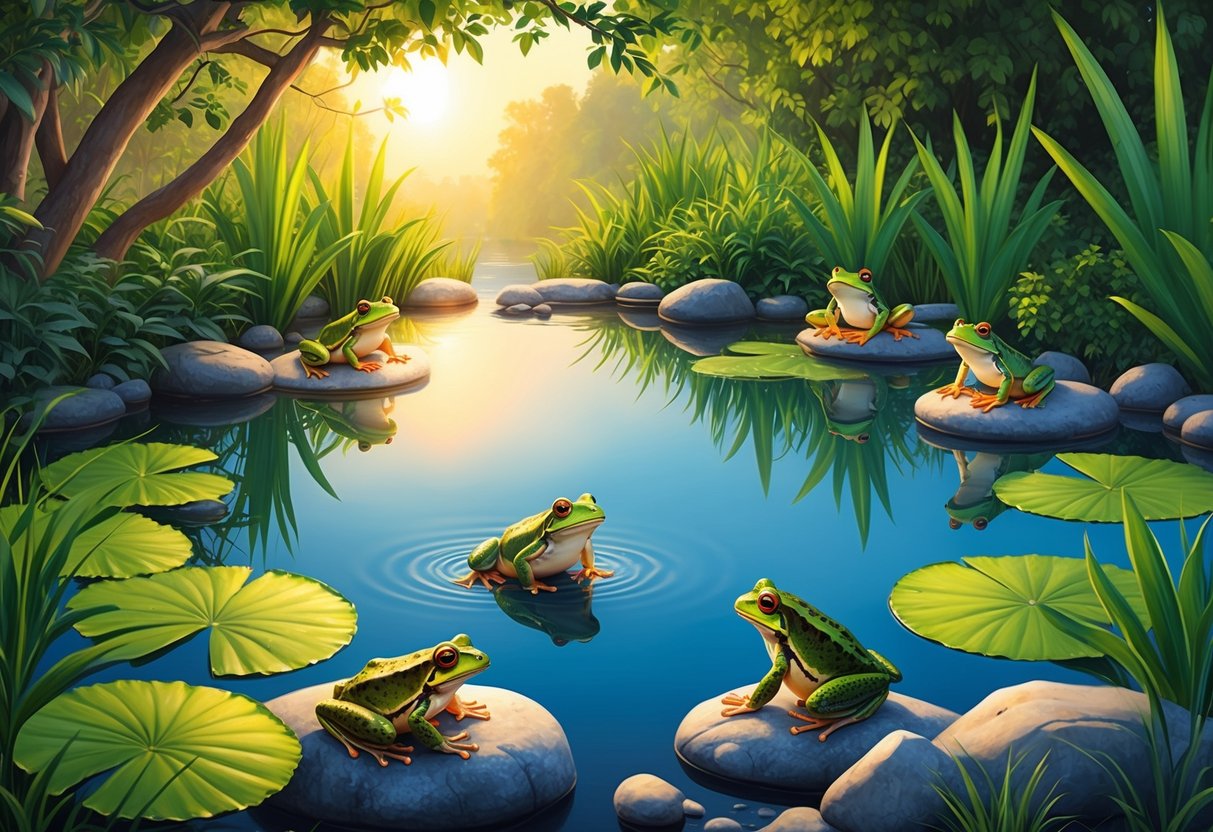
In medieval times, artists showed toads as evil creatures. They were linked to witches and devils. Today, frogs and toads get a much nicer treatment in art. They can be cute, funny, or wise characters.
Different cultures see frogs and toads in unique ways. In China, toads symbolize long life and purity. Japanese art shows them as lucky creatures. Some Native American tribes view frogs as rain-bringers. These varied beliefs shape how artists depict these small, slimy critters.
Historical Depictions of Frogs and Toads
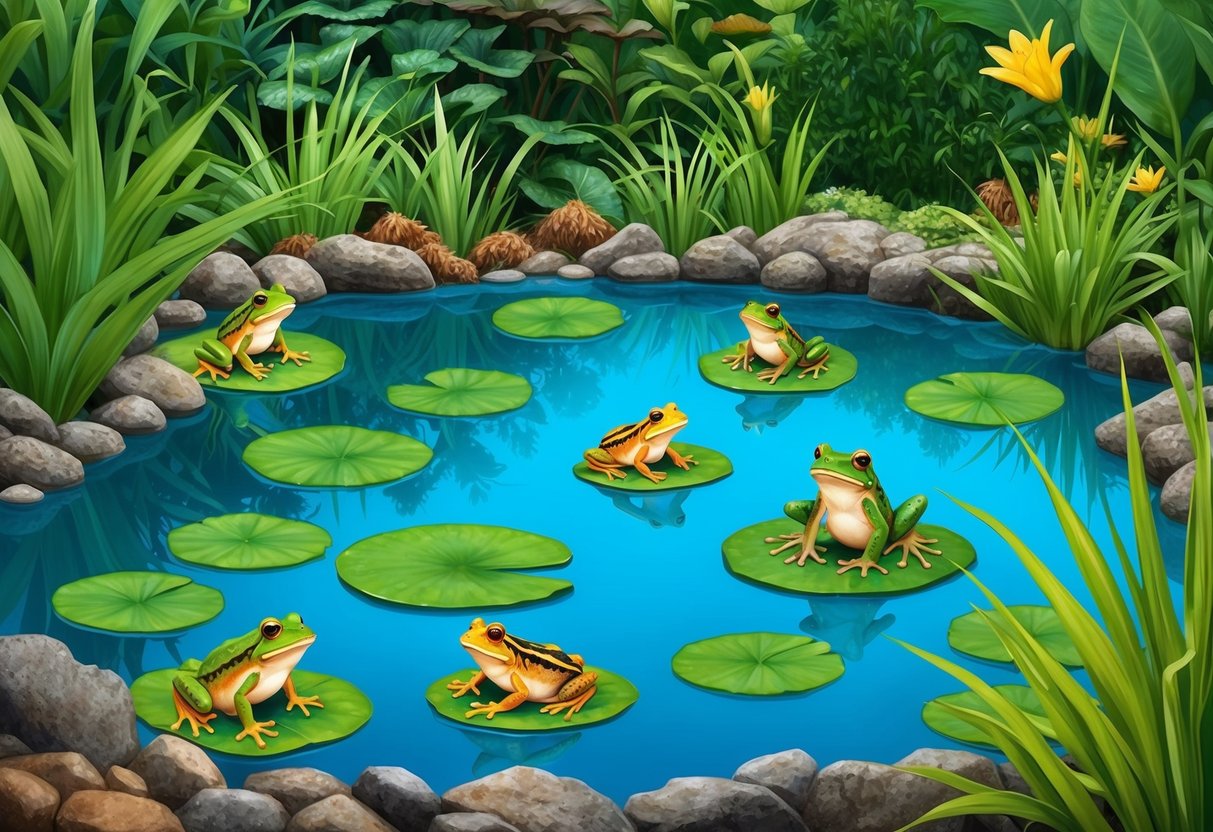
Frogs and toads have been featured in art and literature for centuries. Their portrayal has varied across cultures and time periods.
In ancient Egypt, frogs were symbols of fertility. The goddess Heqet, associated with childbirth, was often depicted with a frog’s head.
Ancient Greek and Roman art linked frogs to fertility and harmony. They also appeared in myths and fables, often as tricksters or wise creatures.
Medieval European art took a different view. Frogs were often shown as pests or symbols of evil. This shift came with the spread of Christianity across the continent.
Chinese culture sees frogs in a positive light. They are symbols of good luck and wealth. Artwork often shows frogs with coins or in prosperous settings.
Aztec art gave frogs a special role. They represented change and new beginnings. This was due to the frog’s ability to live both in water and on land.
In Japanese art, frogs appear in many forms. They are seen in paintings, sculptures, and even poetry. Artists like Getsuju created detailed frog portraits during the Edo period.
Modern art continues to use frogs and toads. They appear in various styles, from realistic nature scenes to abstract representations. Their symbolism remains diverse and complex.
Symbolism of Frogs and Toads in Art
Frogs and toads have been important symbols in art across many cultures and time periods. Their unique life cycle and ability to live both on land and in water make them powerful metaphors.
In ancient Egypt, frogs were linked to fertility and rebirth. The goddess Heqet, who helped with childbirth, was often shown with a frog’s head.
Chinese art sees frogs and toads as lucky creatures. They represent good fortune and wealth. A three-legged toad was believed to live on the moon, explaining lunar eclipses.
Japanese artists like Matsumoto Hoji created toad illustrations that showed toads as mystical beings. In Japan, toads stand for good luck, long life, and protection from evil.
Aztec art gave frogs a darker meaning. Their toad goddess Tlaltecuhtli was fierce and said to swallow the sun, causing eclipses.
Modern art often uses frogs to represent:
- Change and growth
- Connection to nature
- Environmental concerns
Frogs in art can be cute or scary, wise or silly. This range makes them perfect for showing different ideas and feelings in artwork.
Frogs and Toads in Indigenous Art
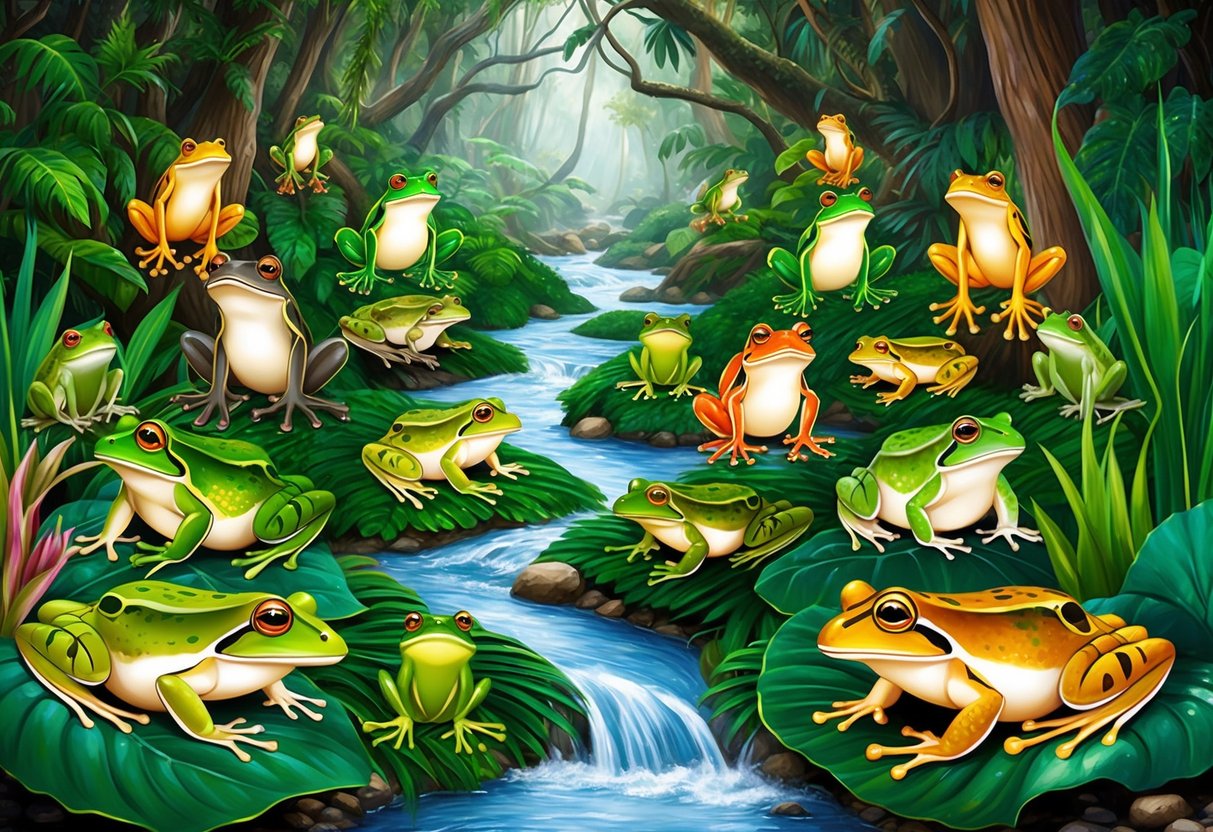
Frogs and toads play important roles in many indigenous art traditions. Their symbolic meanings vary across cultures but often relate to transformation, renewal, and stability.
In Northwest Coast Native art, frogs are significant symbols. They appear on totem poles at the bottom, with legs stretched out to represent stability. Haida artists use frog designs on house posts for structural support.
Frogs in this tradition can also symbolize:
- Wealth
- Abundance
- Ancient wisdom
- Rebirth
- Good luck
The heron, another long-legged creature, represents similar ideas of stability and self-reliance in Northwest Coast art.
Chinese culture views frogs as lucky. They stand for prosperity and good fortune. Aztec beliefs linked frogs to transformation, matching their life cycle from tadpole to adult.
A unique Chinese symbol is the three-legged moon toad. This mythical creature was said to cause lunar eclipses by swallowing the moon.
Native American tribes had varied views on frogs. Some saw them as positive, magical beings. Others viewed frogs as bad omens. Many tribes agreed on frogs’ connection to change and transformation.
Frogs and Toads in Contemporary Art
Frogs and toads continue to fascinate artists in the modern era. These amphibians appear in various forms of contemporary art, from paintings to sculptures and digital media.
Many artists use frogs as symbols of environmental issues. Frogs are seen as indicators of ecosystem health, making them powerful subjects for art about climate change and pollution.
In pop art, frogs often take on playful or ironic roles. Artists like Andy Warhol have featured frogs in their work, giving these creatures a place in mainstream cultural imagery.
Digital artists create hyper-realistic frog renderings, showcasing the diversity of frog species. These detailed artworks help raise awareness about rare and endangered amphibians.
Some contemporary artists draw inspiration from traditional symbolism. They incorporate frogs and toads as symbols of good fortune and renewal, blending ancient beliefs with modern artistic styles.
Installation art sometimes features live frogs, bridging the gap between nature and human-made environments. These exhibits often aim to spark discussions about biodiversity and conservation.
Street art and murals frequently depict larger-than-life frogs in urban settings. These vibrant artworks bring nature into city spaces, reminding viewers of the importance of wildlife.
Frogs and Toads in Popular Culture
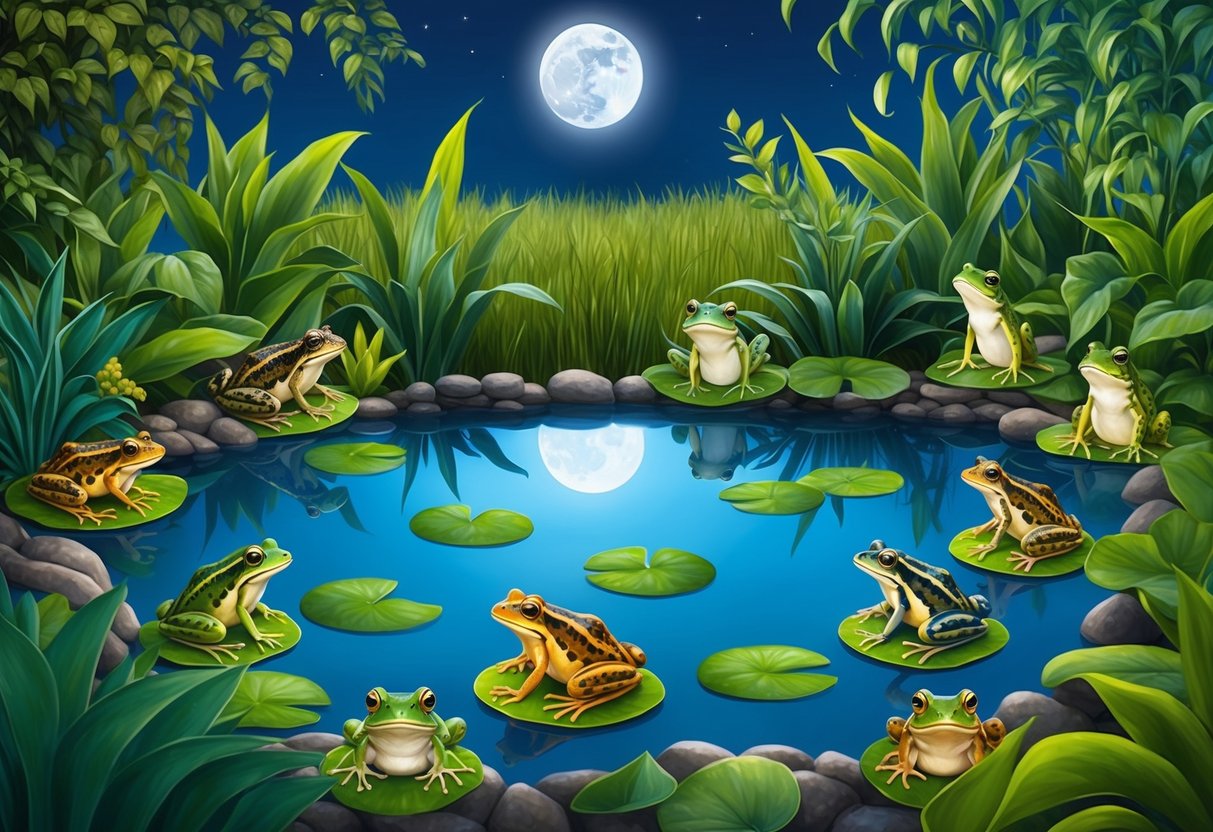
Frogs and toads have hopped their way into many aspects of popular culture. They appear in movies, TV shows, books, and even internet memes.
One of the most famous frog characters is Kermit the Frog from The Muppets. Kermit has been entertaining audiences for decades with his kind personality and catchy songs.
In children’s literature, frogs often play key roles. The classic fairy tale “The Frog Prince” features a frog who turns into a handsome prince when kissed by a princess.
Video games have also embraced frogs as characters. Frogger, a popular arcade game from the 1980s, stars a frog trying to cross busy roads and rivers.
More recently, Pepe the Frog became a well-known internet meme. This cartoon frog has appeared in countless online images and jokes.
Frogs in popular culture often represent:
- Transformation
- Luck
- Friendship
- Comedy
These amphibians continue to capture our imagination in various forms of media. Their unique appearances and behaviors make them perfect subjects for creative works.
Sculpture and Three-Dimensional Art
Frogs and toads have been popular subjects in sculpture for centuries. Artists use various materials to capture these amphibians in three dimensions.
Clay, bronze, and stone are common choices for frog sculptures. These materials allow artists to show the texture of frog skin and create lifelike poses.
Sculptures in art can be small enough to fit in your hand or large enough to sit in a park. Some artists make realistic frog sculptures, while others create more abstract or stylized versions.
Ancient cultures often included frogs in their sculptures. The oldest known metal casting is a copper frog from Mesopotamia, made around 3200 BCE.
Modern sculptors continue to find inspiration in frogs. They might create:
- Garden ornaments
- Public art installations
- Fine art pieces for galleries
Some artists use frogs to represent ideas like:
- Transformation
- Good luck
- Renewal
In Chinese art, frogs often symbolize prosperity. Sculptors might show this by creating golden frog statues or including coins with the frog.
Three-dimensional frog art isn’t limited to traditional sculpture. Some artists use found objects or mixed media to create unique frog-inspired pieces.
Frogs and Toads in Literature and Illustration
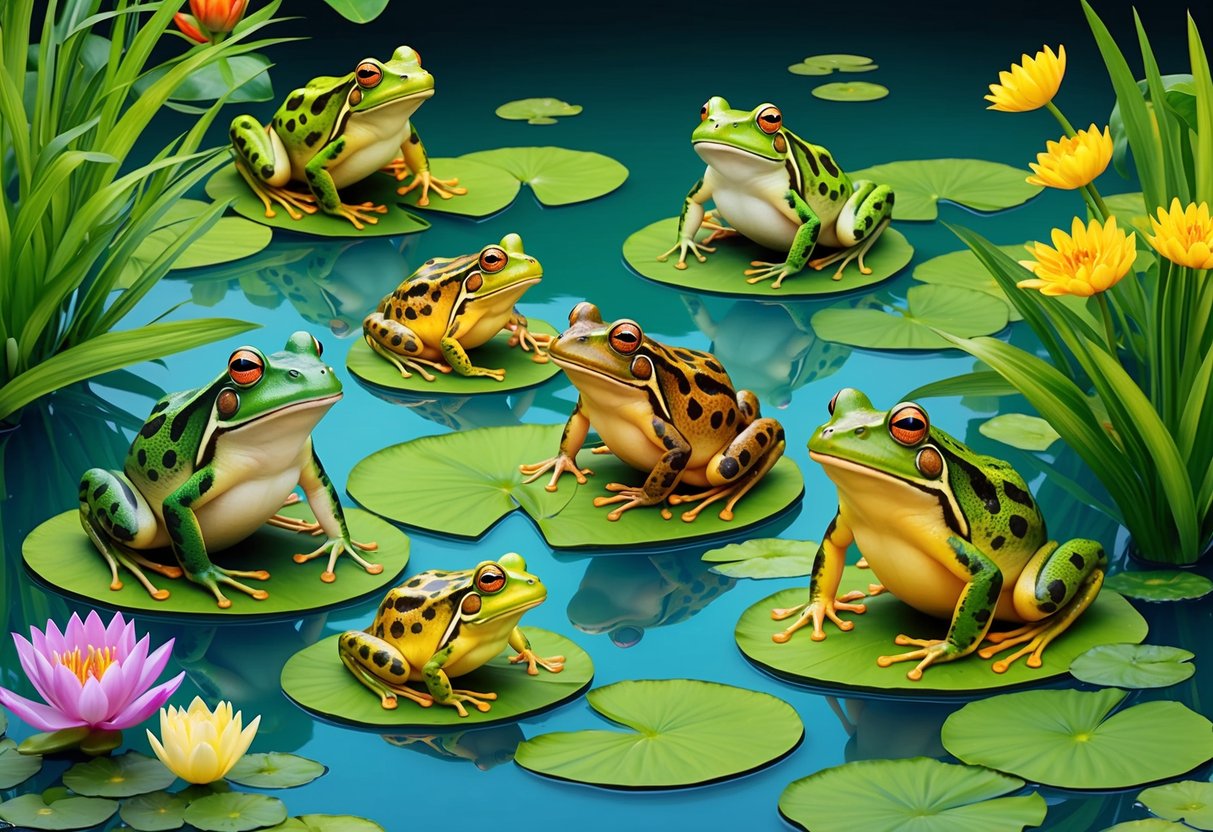
Frogs and toads have hopped their way into many books and artworks over the years. These amphibians often play important roles in stories and pictures.
In fairy tales, frogs sometimes turn into princes when kissed. This idea shows up in many children’s books with colorful drawings of frogs wearing crowns.
Toads appear in lots of stories too. They’re often shown as wise but grumpy characters. In Kenneth Grahame’s “The Wind in the Willows,” Mr. Toad is a main character who gets into trouble.
Frogs are common tricksters in folktales from around the world. They use their smarts to trick other animals or people in funny ways.
Picture books for kids love to use frogs and toads. The bright colors and big eyes of these animals make them fun to draw and paint.
Some famous frog characters in books include:
- Frog and Toad from Arnold Lobel’s series
- The Frog Prince from various fairy tales
- Kermit the Frog from Sesame Street books
Artists often use frogs and toads in their work. These creatures can represent different ideas like change, nature, or magic.
Both frogs and toads show up a lot in poems too. Poets write about their croaking sounds, jumping skills, and slimy skin.
Iconography Across Different Cultures
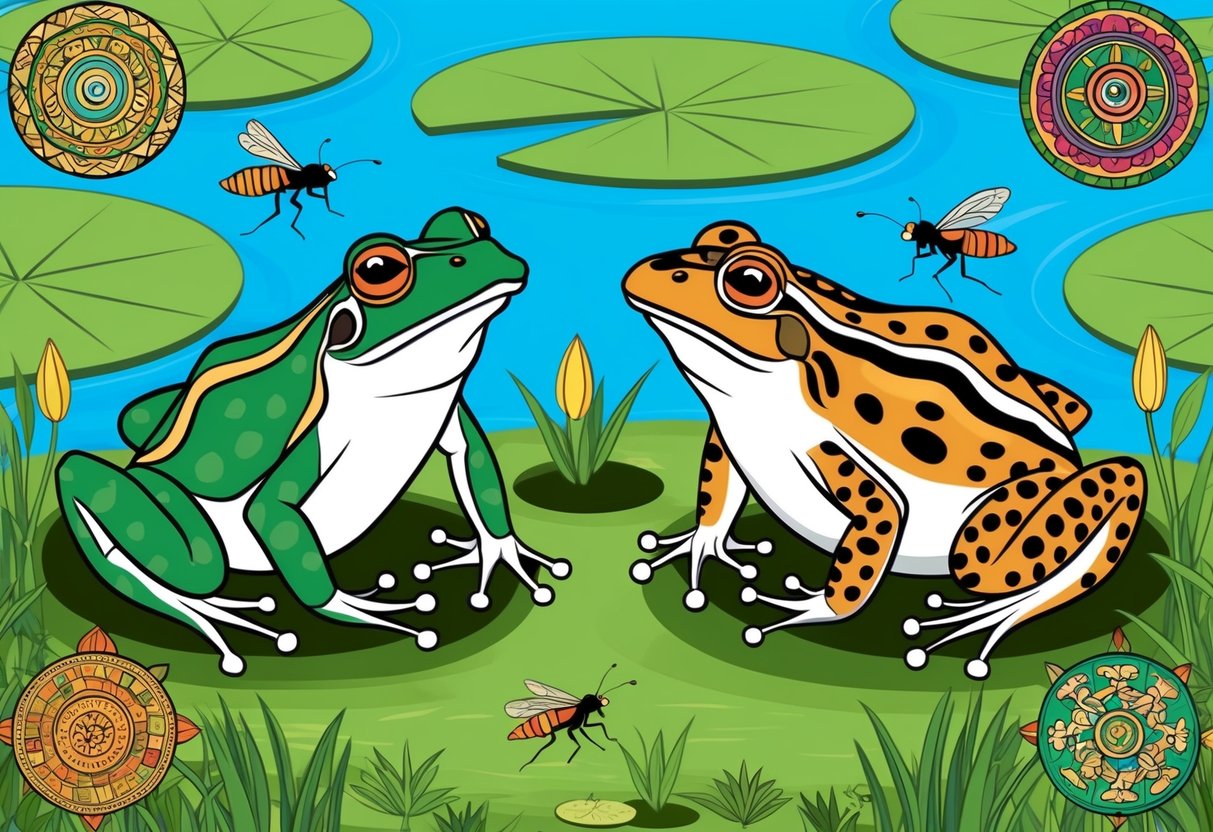
Frogs and toads appear in art from many cultures around the world. Their depictions vary widely, reflecting unique cultural beliefs and symbolism.
Asian Art
In Chinese art, frogs often symbolize good fortune. The three-legged money toad is a popular figure in Feng Shui. It’s believed to attract wealth and ward off bad luck.
Japanese art features the kaeru, a frog that represents safe returns. This comes from a play on words – “kaeru” means both “frog” and “to return” in Japanese.
In Hindu art, frogs are linked to rain and fertility. Some ancient Indian sculptures show frogs in scenes related to agriculture and abundance.
African Art
Many African cultures view frogs as sacred creatures. In ancient Egyptian art, the frog-headed goddess Heqet symbolized fertility and childbirth.
West African folklore often depicts frogs as wise beings. This shows up in traditional masks and carvings, where frog motifs represent knowledge.
Some African tribes use frog imagery in rain-making ceremonies. Their art might show frogs alongside clouds or water symbols.
European Art
Medieval European art sometimes used toads to represent evil or witchcraft. Paintings of witches’ sabbaths often included toads as familiars.
In contrast, some Renaissance art portrayed frogs more positively. They appeared in nature scenes as symbols of transformation and rebirth.
Fairy tale illustrations often feature frogs as enchanted princes. This reflects the “Frog Prince” story popular in European folklore.
American Art
Native American art often includes frog imagery. Many tribes see frogs as rain-bringers and include them in weather-related designs.
In Aztec art, the toad goddess Tlaltecuhtli was a powerful symbol. She was sometimes shown swallowing the sun, explaining eclipses.
Modern American art uses frogs in various ways. From cartoon characters to environmental symbols, frogs continue to appear in diverse artistic contexts.
Ceramics and Craftsmanship
Frogs and toads have long been popular subjects in ceramic art. Artists often capture these amphibians with remarkable detail and skill.
In Vietnamese ceramics, frogs and toads are portrayed with great realism. Craftspeople pay close attention to their size, skin patterns, and even bumpy warts. This careful representation shows the importance of these creatures in Vietnamese culture.
Ceramic frogs and toads come in many forms:
- Figurines
- Flower vases
- Garden ornaments
- Teapots
The Funk art movement brought a new perspective to ceramic art. Artists like Robert Arneson helped transform clay into a more expressive medium. This allowed for more creative and playful depictions of frogs and toads.
In Japan, frogs and toads hold special meaning. They are seen as bringers of good fortune. Japanese artists often include these creatures in their ceramic works, reflecting their cultural significance.
Today, frog and toad ceramics remain popular. Many artists sell their creations on platforms like Etsy. These pieces range from cute, whimsical designs to more realistic sculptures.
Conservation Message Through Art
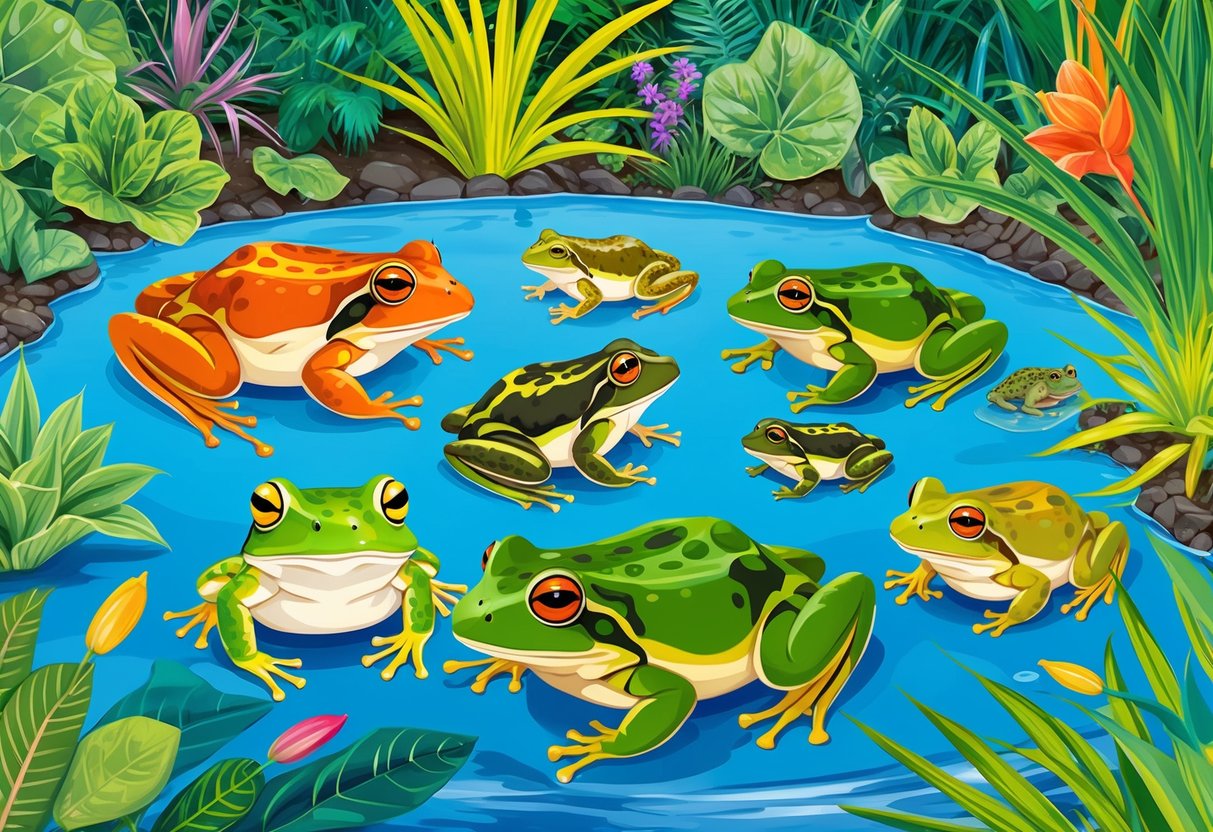
Artists use frogs and toads in their work to highlight environmental issues. These amphibians are sensitive to environmental changes, making them ideal subjects for conservation art.
Paintings and sculptures of frogs often depict their habitats, showing the importance of wetland preservation. Some artists create vivid portraits of endangered frog species to raise awareness about biodiversity loss.
Photography plays a key role in frog conservation art. Close-up images of colorful tree frogs or rare toads can capture public attention and inspire protection efforts.
Art competitions focused on wildlife help raise funds for conservation. These events showcase frog-themed artwork and educate viewers about threats to amphibian populations.
Digital art and animations featuring frogs are used in educational campaigns. These eye-catching visuals help explain complex environmental issues to wider audiences.
Public art installations of oversized frog sculptures in urban areas remind people of nature’s presence. These works often include informational plaques about local frog species and conservation efforts.
Techniques in Portraying Amphibians
Artists use various methods to capture the unique features of frogs and toads in their work. One common approach is detailed macro photography, which shows the intricate textures and colors of amphibian skin.
Painters often emphasize the smooth, moist skin of frogs through glossy finishes and bright colors. For toads, artists may use rougher textures to depict their dry, bumpy skin.
Sculptors can create lifelike amphibian figures using materials like clay, resin, or metal. They pay close attention to details like webbed feet and bulging eyes to make their pieces realistic.
Digital artists use software to render highly detailed amphibian portraits. They can manipulate lighting and color to highlight specific features or create fantastical versions of frogs and toads.
Some key elements artists focus on when portraying amphibians include:
- Large, expressive eyes
- Wide mouths and distinctive head shapes
- Powerful back legs for jumping
- Skin texture (smooth for frogs, bumpy for toads)
- Vibrant colors, especially for tropical species
Camouflage techniques are often incorporated to show how these creatures blend into their environments. Artists might use mottled patterns or earthy tones to depict this natural ability.
Interactive Art and Amphibians
Interactive art featuring frogs and toads engages viewers in unique ways. These works often blend technology and nature to create immersive experiences.
Digital installations allow people to interact with virtual amphibians. Visitors might use touch screens or motion sensors to explore frog habitats or life cycles.
Some artists create large-scale frog sculptures that react to human presence. These pieces may light up, make sounds, or move when someone approaches.
Augmented reality apps bring frogs and toads to life in unexpected places. Users can point their phones at specific markers to see 3D amphibians appear in their environment.
Interactive murals featuring amphibians are popular in schools and museums. Children can touch different parts of the mural to learn facts about frogs and toads.
Some exhibits use sound to create an interactive experience. Visitors walk through spaces filled with recordings of various frog calls, creating a virtual wetland.
These interactive artworks serve an educational purpose too. They often teach about amphibian conservation and the importance of protecting frog habitats.
Frogs and Toads in Photography
Frogs and toads are popular subjects in nature photography. Their unique features and habitats make them interesting to capture on camera.
Photographers often focus on getting close-up shots of frogs’ eyes. The large, colorful eyes of many frog species create striking images.
Lighting is key when photographing these amphibians. Soft, diffused light helps show details without harsh shadows. Some photographers use flash diffusers to soften the light on frogs.
Water adds an extra element to frog photos. Reflections and droplets can create beautiful effects. Underwater photography of frogs and tadpoles requires special equipment and techniques.
Patience is crucial for frog photography. Waiting quietly for the right moment can lead to unique shots, like a toad on frogspawn.
Camera settings for frog photos:
- Fast shutter speed to freeze motion
- Wide aperture for shallow depth of field
- Higher ISO in low light conditions
Frog photography isn’t limited to expensive gear. Even entry-level cameras can capture award-winning images with the right technique and timing.
Ethical considerations are important. Photographers should avoid disturbing frogs or their habitats while taking pictures.
Frequently Asked Questions
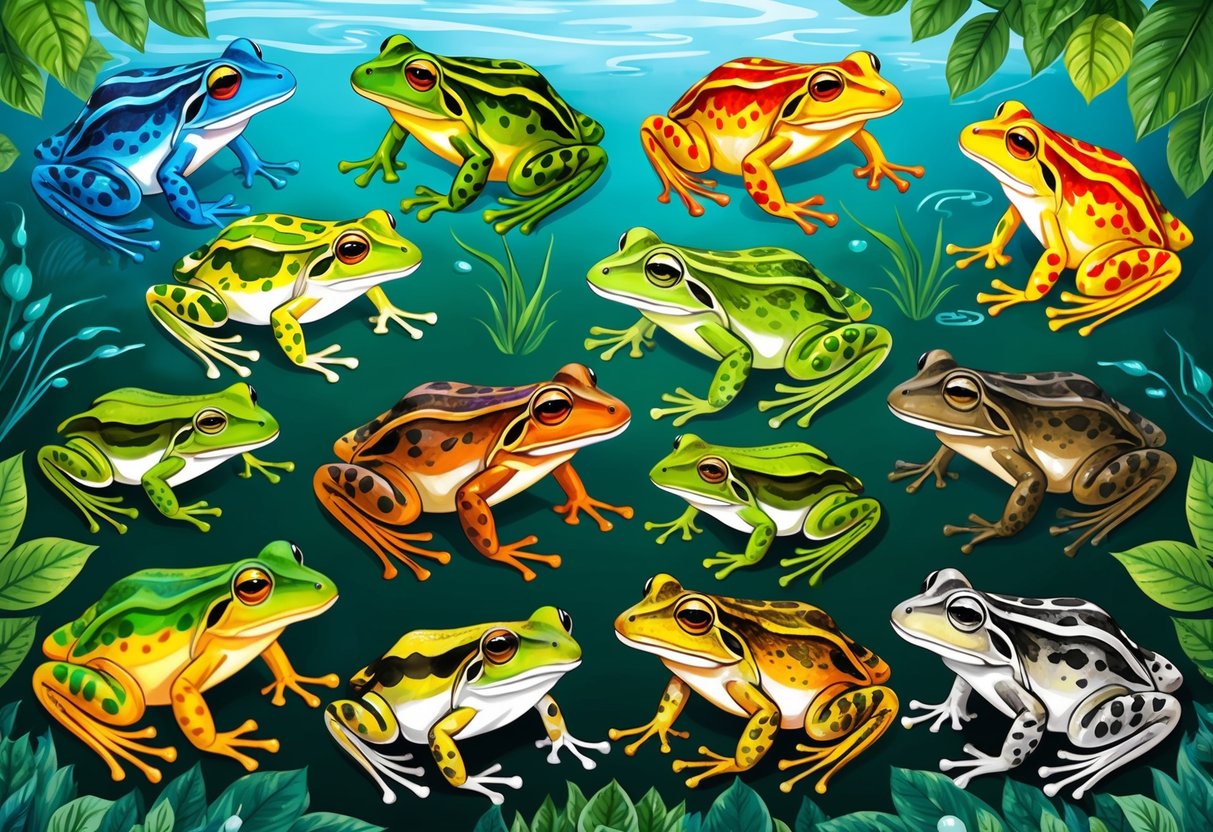
Frogs and toads play important roles in art, folklore, and cultural symbolism around the world. Their unique appearances and behaviors have inspired artists across many traditions to incorporate these amphibians into diverse works and meanings.
How have frogs been used as symbols throughout art history?
Frogs often symbolize transformation and rebirth in art. This stems from their dramatic metamorphosis from tadpole to adult.
Artists have used frog imagery to represent personal growth and change.
In some artworks, frogs appear as symbols of fertility and abundance. Their association with water and rainy seasons connects them to ideas of life and renewal in various cultures.
What is the significance of frogs and toads in folklore and mythology as represented in artwork?
Many folktales portray frogs as clever tricksters. Artists often depict these stories in paintings and sculptures, showing frogs outsmarting other characters.
Some myths feature frogs as magical creatures with the power to grant wishes or curses. Artwork inspired by these tales might show frogs wearing crowns or possessing other magical attributes.
In what ways have artists incorporated the image of the toad in their work?
Artists frequently highlight the warty, bumpy texture of toad skin in their work. This unique feature makes toads stand out in sculptures and detailed paintings.
Some artists use toads to represent wisdom or patience in their pieces. The toad’s calm demeanor and long lifespan contribute to this symbolic meaning.
How do different cultures interpret the presence of frogs and toads in their artistic expression?
In ancient Egyptian art, the frog goddess Heqet symbolized fertility and birth. Artists often depicted her with a frog’s head in sculptures and hieroglyphs.
Chinese art sometimes features the three-legged money toad as a symbol of prosperity. This mythical creature appears in paintings and sculptures, often shown with coins in its mouth.
What religious or spiritual meanings are attached to frogs in various art forms?
Some Christian artworks use frogs to represent sin or temptation. This interpretation stems from biblical plagues where frogs were seen as a divine punishment.
In Aztec art, the frog god Tlaltecuhtli represented the earth and creation. Artists carved this deity into stone monuments and crafted intricate frog-shaped artifacts.
How are the life cycle and habitat of amphibians depicted in various artistic traditions?
Many artists capture the frog’s transformation from egg to tadpole to adult. This life cycle often appears in sequential paintings or sculptures, highlighting each stage.
Pond scenes featuring frogs are common in landscape paintings. Artists use these scenes to depict natural habitats and the interplay between water and land environments.
